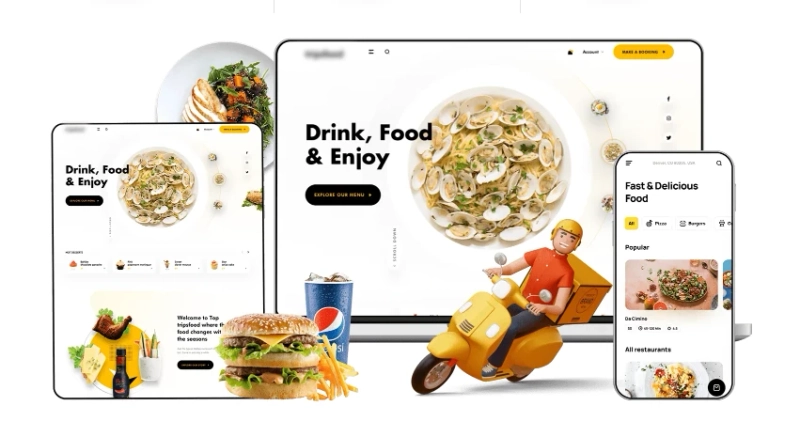In the digital age, convenience is king, especially when it comes to satisfying our appetites. With the exponential growth of food delivery app development services, mobile apps have become the go-to platform for hungry consumers looking to indulge in their favorite cuisines without leaving the comfort of their homes. However, not all food delivery apps are created equal. To stand out in a saturated market and provide a seamless user experience, certain key features are essential. In this blog post, we'll explore the must-have features that should be included in a food delivery mobile app to ensure customer satisfaction and business success.
Intuitive User Interface (UI) and User Experience (UX):
The first impression is crucial for any app, and a user-friendly interface is paramount for ensuring a positive experience. A clean and intuitive UI design coupled with smooth navigation enhances user engagement and encourages repeat usage. Users should be able to easily browse through menus, place orders, and track their deliveries with minimal effort.
Seamless Registration and Login:
Simplifying the registration and login process is essential for reducing friction and encouraging user adoption. Offering multiple authentication options such as email, social media, or phone number verification allows users to choose the method most convenient for them. Additionally, enabling guest checkout for first-time users can expedite the ordering process and improve conversion rates.
Comprehensive Search and Filter Options:
A robust search functionality with advanced filtering options empowers users to quickly find their desired dishes or restaurants based on various criteria such as cuisine type, price range, dietary preferences, and distance. Implementing features like autocomplete suggestions and saved preferences further enhances the user experience and facilitates personalized recommendations.
Detailed Menu with High-Quality Imagery:
A visually appealing menu with vivid images and detailed descriptions entices users and helps them make informed decisions. Including key information such as ingredients, portion sizes, allergen warnings, and nutritional values enhances transparency and builds trust with customers. Additionally, integrating user-generated reviews and ratings can assist users in selecting popular or highly-rated dishes.
Secure Payment Gateway:
Security is paramount when handling sensitive financial information, especially in the realm of online transactions. Integrating a secure payment gateway that supports various payment methods such as credit/debit cards, digital wallets, and mobile payment platforms ensures smooth and secure transactions. Implementing encryption protocols and complying with industry standards for data protection instills confidence in users and mitigates risks associated with online payments.
Real-Time Order Tracking:
Providing users with real-time updates on the status of their orders enhances transparency and reduces anxiety associated with waiting for deliveries. Implementing GPS tracking technology allows users to track the location of their delivery drivers in real-time and receive notifications at key milestones such as order confirmation, preparation, and dispatch. Additionally, estimated delivery times should be dynamically adjusted based on factors like traffic conditions and order volume to provide accurate delivery predictions.
Seamless Communication Channels:
Effective communication is essential for resolving issues and providing timely support to users. Integrating in-app messaging or chat support enables users to easily reach out to customer support representatives for assistance with order inquiries, customizations, or complaints. Implementing automated notifications for order confirmations, delays, or promotions keeps users informed and engaged throughout the ordering process.
Loyalty Programs and Rewards:
Implementing a robust loyalty program incentivizes repeat purchases and fosters customer loyalty. Offering rewards points, discounts, or exclusive perks for frequent users encourages retention and drives customer engagement. Additionally, personalized recommendations based on past orders and preferences can enhance the relevance of promotions and increase customer satisfaction.
Integration with Social Media Platforms:
Harnessing the power of social media can amplify brand awareness and drive user acquisition. Integrating social sharing features allows users to easily share their dining experiences, reviews, and photos on popular platforms like Facebook, Instagram, and Twitter. Leveraging user-generated content and social proof can attract new customers and foster a sense of community among users.
Analytics and Insights:
Gathering and analyzing data on user behavior, preferences, and trends is essential for optimizing app performance and driving business growth. Implementing analytics tools and dashboards enables stakeholders to gain valuable insights into key metrics such as order volume, conversion rates, average order value, and customer demographics. Leveraging this data allows businesses to make data-driven decisions, refine marketing strategies, and enhance the overall user experience.
In conclusion, building a successful food delivery mobile app requires careful consideration of the key features that enhance usability, convenience, and customer satisfaction. By prioritizing intuitive design, seamless functionality, and personalized experiences, businesses can differentiate themselves in a competitive market and build lasting relationships with their users. By continuously iterating and refining the app based on user feedback and emerging trends, businesses can stay ahead of the curve and deliver an exceptional culinary experience to their customers.


